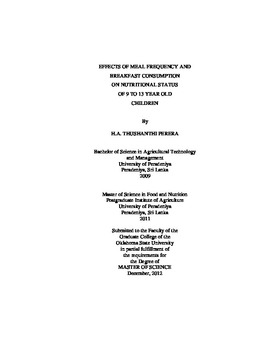| dc.contributor.advisor | Gates, Gail E. | |
| dc.contributor.author | Perera, HA Thushanthi | |
| dc.date.accessioned | 2014-04-15T22:01:28Z | |
| dc.date.available | 2014-04-15T22:01:28Z | |
| dc.date.issued | 2012-12-01 | |
| dc.identifier.uri | https://hdl.handle.net/11244/9263 | |
| dc.description.abstract | Meal and snacking patterns are thought to influence body weight and nutrient intakes among children and adolescents. Snacking has increased in the United States over the last 25 years and became one of the major dietary behaviors of interest. Therefore, the objective of this study was to investigate the effects of meal and snacking frequency on energy, macronutrient and micronutrient intake, laboratory indicators, waist circumference and body mass index (BMI) z-scores among a cohort of nationally representative children. A sample of 1,261 9 to 13 year olds was selected from 2007-2010 National Health and Nutrition Examination Survey (NHANES). Two-day dietary data were extracted along with demographic data. Multivariate adjusted ANOVA and regression analyses were performed. Data were analyzed using SAS and SUDAAN. On average subjects reported a daily eating frequency of 4.35 with 2.4 snacking occasions. No significant associations were found with respect to BMI z-scores, waist circumference or laboratory indicators except for the breakfast skipping which was associated with higher total blood cholesterol. Daily eating and snacking frequency were significantly associated with consumption of energy, macronutrients, and several vitamins and minerals. More frequent eaters had higher intakes of energy and macronutrients and most of the micronutrients. Compared to the least frequent snackers, children who had three or more snacks consumed the highest amounts of energy, macronutrients, vitamin E, calcium, phosphorous, magnesium, iron, sodium, potassium and moisture. Breakfast skippers had lower intakes of folate, vitamins A and D, phosphorous, iron, potassium and sodium and higher intakes of cholesterol but there was no significant association with macronutrient consumption. Findings from this cross sectional survey suggest that meal and snacking frequency plays an integral role in provision of adequate macronutrients and micronutrients for youth. Breakfast skipping is associated with lower consumption of certain important nutrients. | |
| dc.format | application/pdf | |
| dc.language | en_US | |
| dc.publisher | Oklahoma State University | |
| dc.rights | Copyright is held by the author who has granted the Oklahoma State University Library the non-exclusive right to share this material in its institutional repository. Contact Digital Library Services at lib-dls@okstate.edu or 405-744-9161 for the permission policy on the use, reproduction or distribution of this material. | |
| dc.title | Effects of Meal Frequency and Breakfast Consumption on Nutritional Status of 9 to 13 Year Old Children | |
| dc.type | text | |
| dc.contributor.committeeMember | Kennedy, Tay S. | |
| dc.contributor.committeeMember | Shriver, Lenka H. | |
| osu.filename | Perera_okstate_0664M_12508.pdf | |
| osu.college | Human Environmental Sciences | |
| osu.accesstype | Open Access | |
| dc.description.department | Department of Nutritional Sciences | |
| dc.type.genre | Thesis | |
| dc.subject.keywords | body mass index | |
| dc.subject.keywords | breakfast | |
| dc.subject.keywords | children | |
| dc.subject.keywords | nhanes | |
| dc.subject.keywords | nutrient intake | |
| dc.subject.keywords | snacking | |
